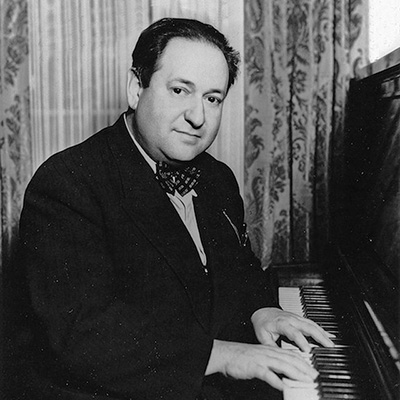Erich Wolfgang Korngold

- Born: May 29, 1897, Brno, Czechia
- Died: November 29, 1957, Hollywood, California
Concerto in D Major for Violin and Orchestra
- Composed: 1937-1945
- Premiere: February 15, 1947, St. Louis, Vladimir Golschmann conducting the St. Louis Symphony; Jascha Heifetz, violinist
- Instrumentation: solo violin, 2 flutes (incl. piccolo), 2 oboes (incl. English horn), 2 clarinets, bass clarinet, 2 bassoons (incl. contrabassoon), 4 horns, 2 trumpets, trombone, timpani, bass drum, bell, crash cymbals, glockenspiel, suspended cymbals, tuned gongs, vibraphone, xylophone, harp, celeste, strings
- CSO notable performances: First Performance: February 2000, John Morris Russell conducting with Timothy Lees, violin. Most Recent Performance: February 2015, Han-Na Chang conducting with Simone Lamsma, violin.
- Duration: approx. 24 minutes
When Erich Wolfgang Korngold was nine years old, his father—who happened to be Julius Korngold, the most influential music critic in Vienna—showed the boy’s first compositions to Gustav Mahler, who exclaimed: ‟A genius!” Mahler’s reaction was understandable. The young Korngold was a unique composing prodigy who had an instinctive grasp of the most modern musical styles of the day. He grew up to be an extremely successful opera composer—he wrote his most talked-about work, Die tote Stadt (‟The Dead City”), when he was 20. Yet, he was equally attracted to operetta and was considered an expert on Johann Strauss, Jr. His involvement with new productions of Die Fledermaus and other Strauss operettas (as arranger and conductor) became legendary and brought him into contact with Max Reinhardt (1873–1943), the foremost German stage director of the time. This turned out to be a life saver, as it was with Reinhardt that Korngold first went to Hollywood, where he soon became the star among film composers. After the Nazi occupation of Austria in 1938, Korngold lost his original home base and settled permanently in Los Angeles.
His father, music critic Julius Korngold, who in his 70s was forced to flee Austria and joined his son in Southern California, was deeply disappointed that Erich had given up ‟serious” composition in favor of the movies. To his last day, the old man kept exhorting his son to return to concert music. His advice went unheeded for years, yet toward the end of Julius’s life, Erich wrote a string quartet (his third) and, after his father’s death, he returned to a project started years earlier but never completed: a concerto for violin and orchestra.
The great violinist Bronislaw Huberman—an old family friend since Vienna days—had long been asking Korngold for a violin concerto. When the work was finally completed, however, Huberman found himself unable to commit to a performance date. (The Polish violinist was in poor health and died in June 1947 at the age of 64). Korngold showed the concerto to Jascha Heifetz, who learned it within a few weeks and, with Huberman’s blessing, gave the world premiere in St. Louis on February 15, 1947.
At this point in Korngold’s career, the two aspects of his creative world—concert and film music—had become completely intertwined. His movie scores (of which the most famous are Captain Blood and The Adventures of Robin Hood) were symphonic, even operatic, in their scope. The Violin Concerto, conversely, owes much to Korngold’s work in the film industry. Many of the major themes were taken over from movie scores, and there are moments where the instrumentation and the thematic development also bring back Hollywood memories.
The opening theme of the concerto comes from a score written for a film that failed and was quickly forgotten (Another Dawn, 1937), the second from the historical movie Juarez (1939). The folk-dance theme of the last movement originated in the film adaptation of Mark Twain’s The Prince and the Pauper (1937) and became the starting point for a set of brilliant variations. These different sources come together to form a completely new entity in the Violin Concerto, quite independent from the screen originals. (The beautiful melody of the second movement ‟Romance” seems to have been written especially for this concerto.)
In Korngold’s personal style, elements inherited from Mahler and Richard Strauss are treated with the light touch perfected at the Warner Brothers studios. This approach brought Romantic concerto-writing to new life at a time when most modern composers and critics were ready to bury it. Korngold himself never had any doubts about the vitality of this tradition. His rich melodic invention, his ‟spicy” harmonies that nevertheless remain firmly anchored in tonality, and his perfect understanding of the virtuoso violin idiom enabled him to make an important contribution to the repertoire. Yet at first, the concerto found little favor with violinists, despite Heifetz’s strong advocacy. (Heifetz recorded the work twice: once with the New York Philharmonic and once with the Los Angeles Philharmonic.) Since the 1970s, Korngold’s Violin Concerto has enjoyed a spectacular comeback, with numerous recordings and frequent concert performances all over the world.
—Peter Laki